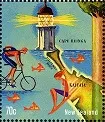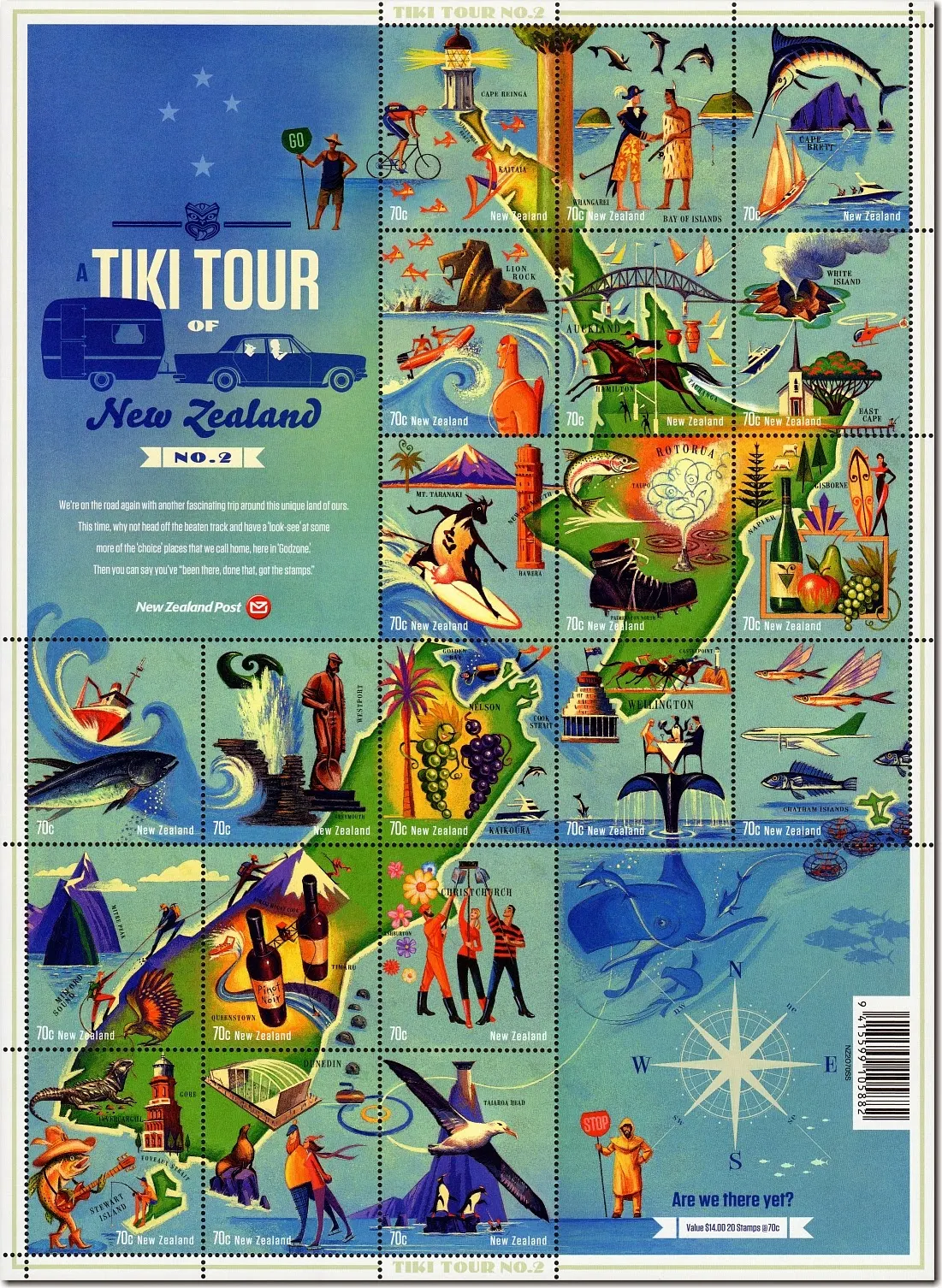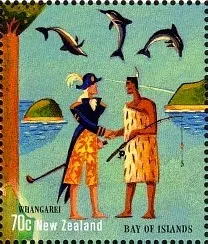

The Second Tiki Tour of New Zealand showed a lot more colour than the original Tiki Tour in 2009. (2009 - A Tiki Tour of New Zealand)
It was a similar format featuring various places around New Zealand in stylised/cartoon type illustrations on a map of New Zealand. Some of the places and scenes had been seen in the first series, but here many were completely new.
We have laid out this post with a brief summary of the series taken from the NZ Post web site. Then we show the actual sheet as it was issued. Below this you will find a set of three First Day Covers. Finally we have laid out all 20 stamps separately with some information about places shown.
Your 'Tiki Tour' starts here!
 Start up north where there’s a bloke holding a sign that says ‘Go’ and you’ll soon be amongst the great kauri forest, and picturesque Bay of Islands. While you’re there, why not take in some history at the meeting place of Pākehā and Māori peoples, and perhaps even sail through the hole in the rock at Cape Brett?
Start up north where there’s a bloke holding a sign that says ‘Go’ and you’ll soon be amongst the great kauri forest, and picturesque Bay of Islands. While you’re there, why not take in some history at the meeting place of Pākehā and Māori peoples, and perhaps even sail through the hole in the rock at Cape Brett?
As you reach the City of Sails, you’ll come across the iconic Harbour Bridge. Carry on through the Coromandel – known for its beaches as well as its pottery - and you’ll soon reach the mighty Waikato, where equestrian activities take pride of place.
 Taranaki is dairy country and also a great place to catch a wave – perhaps you’ll spot a surfing cow! Stop in for some trout fishing at Taupo or experience the thermal wonderland of Rotorua before reaching the East Coast – an area that combines art deco architecture with fabulous vineyards and orchards.
Taranaki is dairy country and also a great place to catch a wave – perhaps you’ll spot a surfing cow! Stop in for some trout fishing at Taupo or experience the thermal wonderland of Rotorua before reaching the East Coast – an area that combines art deco architecture with fabulous vineyards and orchards.In the nation’s capital, the Beehive is hard to miss. You might not dine on the tail of a Kaikoura whale, but you can’t pass through without experiencing the café culture and fine dining on which Wellington prides itself.
 Cross the Cook Strait to the fantastic scuba diving spots of the Abel Tasman region, before immersing yourself in the Marlborough wine country. Experience the Cantabrian spirit in New Zealand’s garden city before taking on a little adventure in Queenstown – whether it’s bungy jumping or jet boating, you’ll need to hold on to your hat!
Cross the Cook Strait to the fantastic scuba diving spots of the Abel Tasman region, before immersing yourself in the Marlborough wine country. Experience the Cantabrian spirit in New Zealand’s garden city before taking on a little adventure in Queenstown – whether it’s bungy jumping or jet boating, you’ll need to hold on to your hat! Farther south, take in a match at Dunedin’s new stadium or sing a little country music in Gore. Why not do some seal-spotting while you’re there and maybe even venture over to Stewart Island for a touch of fishing? But whatever happens, be sure to take it easy and enjoy the scenery!
Farther south, take in a match at Dunedin’s new stadium or sing a little country music in Gore. Why not do some seal-spotting while you’re there and maybe even venture over to Stewart Island for a touch of fishing? But whatever happens, be sure to take it easy and enjoy the scenery!You may have reached the sign that says ‘Stop’, but the journey’s not over! Take the Tiki Tour again and you’ll discover even more unique sights that make up the land us Kiwis call home.
The Full Sheet.
The issue only appeared in this full sheet format containing 20 stamps. Separate stamps were not sold by NZ Post. Also on sale were a set of three Special Covers used mainly for First Day Covers.
First Day Covers.
Notice the car & caravan cancelation stamp on each cover.
First Day Cover One shows the six stamps covering the top of the North Island.
First Day Cover Two shows the next eight stamps cover the middle parts of New Zealand surrounding Cook Strait.
First Day Cover Three shows the last six stamps covering the lower South Island.
The 20 Stamps.
70c - Cape Reinga / Kaitaia.
They call this the 'winterless north,' the strip of land from the northern town of Kaitaia
right up to Cape Reinga where the two oceans meet. Down the western side is the long
straight stretch of sand known as Ninety Mile Beach.
70c - Whangarei / Bay of Islands.
The Bay of Islands, a place of history; the first missionary settlement, the first New Zealand
capital, where Maori and Pakeha (European) met to sign the Treaty of Waitangi.
Whangarei, further south, is the commercial capital of Northland.
For an index to all our posts concerning The Maori People.
70c - Cape Brett / Piercy Island.
On the outer edge of the Bay of Island lies Cape Brett with its famous lighthouse.
Off shore is Piercy Island with the famous 'Hole in the Rock' which tour boats
regularly go through. The area is popular for fishing and pleasure craft too.
70c - Lion Rock / West Coast Auckland.
To the west of Auckland City the rugged west coast beaches can be found, among them is
Piha Beach with its famous Lion Rock. The large waves continuously rolling in makes
these beaches popular for surfing.
70c - Auckland / Hamilton / Tauranga.
Auckland is connected to its northern suburbs via the harbour bridge which actually
looks nothing like the one shown here. Its New Zealand's largest city with nearly a
quarter of the countries' population living here. Further south around Hamilton is
the Waikato farming region. Known for dairy and horses.
70c - White Island / East Cape.
Off the coast of the Bay of Plenty is the volcano called White Island. This island is
active all the time with some very violent eruptions every few years. Then the very
Eastern tip of New Zealand is called East Cape.
70c - Mount Taranaki / New Plymouth / Hawera.
Without a doubt the feature of this stamp must be the beautiful Mount Taranaki,
even though it appears in the background. This volcano rises from the flat
Taranaki Plains to this almost symmetrical cone. That cow riding a surf
board adds a bit of humour too.
70c - Rotorua / Taupo / Palmerston North.
This stamp covers the Central Volcanic plateau from Rotorua in the north
through to Palmerston North in the south. The stamp shows a rugby boot,
a rainbow trout and volcanic/thermal activity. Notice the Maori caving
appearing in the cloud from the volcano.
70c - Gisborne / Napier.
The rather isolated city of Gisborne and further south the twin cities of Napier
and Hastings are famous for growing fruit and for wine. Napier was the site of
a devastating earth quake that totally destroyed the city in 1931.
70c - West Coast Fishing.
The fishing boat shown is after the prized tuna, used domestically and for
exporting overseas. The waves shown point to the Tasman Sea always being
rougher than the eastern Pacific Coast.
70c - Westport / Greymouth.
Westport is a town in the West Coast region of the South Island of New Zealand.
It is located on the northern bank and at the mouth of the Buller River, close
by the prominent headland of Cape Foulwind. Greymouth (Māori: Māwhera)
is the largest town in the West Coast region and the seat of the
Grey District Council. The town is located at the mouth of the Grey River,
on a narrow coastal plain close to the foot of the Southern Alps.
70c - Golden Bay / Nelson / Cook Strait.
Fruit growing, grapes and wine is what the areas situated at the northern end
of the South Island are known for. Protected by the northern end of the Southern Alps
in Abel Tasman National Park this area is sheltered from the worst weather
while across Cook Strait Wellington gets much more wind.
70c - Castle Point / Wellington.
Wellington is the capital of New Zealand. The building shown is the 'Beehive'
one of the buildings of parliament where the Prime Minister has his office.
Away to the east is the spectacular Castle Point with its famous lighthouse.
The point is located on a rocky headland which almost becomes an island at
high-tide or in rough weather.
70c - Chatham Islands.
Far out in the Pacific Ocean, 680 kilometres (423 mi) southeast of mainland
New Zealand, the Chatham Islands is another world. Most of the economy
here is based on fishing and crayfishing, with a bit of farming and tourism.
I am unsure why that aircraft is taking centre place on the stamp.
70c - Mitre Peak / Milford Sound.
The spectacular Milford Sound is the feature of this stamp. And there is
Mitre Peak again too. We did a post showing the number of times this
peak appeared on New Zealand postage stamps. Also shown is mountain
climbing and the native parrot the Kea, found in forested and alpine
regions of the South Island.
70c - Aoraki/Mount Cook / Timaru / Queenstown.
Historically, the Māori name has been spelt Aorangi, using the standard
Māori form, but today it is normally referred to as Aoraki/Mount Cook.
This is New Zealand highest peak set deep in the Southern Alps. The rolling
foot hills are protected by the high peaks which makes it great wine
growing country with many of our finest reds produced in this region.
70c - Christchurch / Ashburton.
Christchurch by far the largest city in the South Island. Now as a 'garden city'
because of the many flower gardens, both public or private, found
throughout the city. Also shown is the rugged Banks Peninsular, an old
series of ancient volcanoes.
70c - Gore / Invercargill / Foveuax Strait / Stewart Island.
Invercargill (Māori: Waihōpai) is the southernmost and westernmost city
in New Zealand, to many the southern most town although the small
village/seaport of Bluff 30km further south takes that title. Across
Foveuax Strait lies Stewart Island with a permanent population of
381 people as of the 2013 census, and much of the island is now
protected in various conversation reserves and parks.
Check out that folk singing fish.
70c - Dunedin.
Dunedin (Maori: Ōtepoti) is the second-largest city in the South Island of New Zealand,
and the principal city of the Otago Region. At one point back in the
Otago Gold Rush, Dunedin was the largest city in New Zealand. Today it is
the 7th largest city. The city's largest industry is tertiary education – Dunedin
is home to the University of Otago, New Zealand's first university (established 1869),
and the Otago Polytechnic.
70c - Taiaroa Head.
With gold being discovered in Central Otago, the city of Dunedin had quickly
become one the more important ports of the young country of New Zealand.
One of the earliest lighthouses erected in New Zealand, this light came
into operation on 2 January 1865. Situated 58 metres above sea level at the
southern side and seaward entrance to Otago harbour, the Taiaroa Head Light
guided shipping into Port Chalmers, the port for the city of Dunedin.
The tower was built from stone quarried on the site.
Technical information:
Date of issue:
| 4 July 2012 |
|---|---|
Number of stamps:
| 20 gummed stamps |
Stamps and first day covers designed by:
| Assignment Group, Wellington, New Zealand. Designer, Geoff Francis. Illustrator, Evan Purdie |
Denominations:
| 20 x 70c |
Printer and process:
| Southern Colour Print Ltd by offset lithography |
Number of colours:
| Four process colours plus Synseal spot overgloss |
Stamp size and format:
| 35mm x 40.6mm (vertical) |
Paper type:
| Tullis Russell 104gsm red phosphor gummed stamp paper |
Number of stamps per sheet:
| 20 |
Perforation gauge:
| 14.286 x 14.286 |
Period of sale:
| Unless stocks are exhausted earlier, these stamps will remain on sale until 3 July 2014 |
Some of the images in this post were used with permission from the illustrated catalogue of StampsNZ
You can visit their web site and On-line Catalogue at, http://stampsnz.com/






















Hi, regarding this stamp (70c - Aoraki/Mount Cook / Timaru / Queenstown.) what are those round objects in the water next to the wine?
ReplyDeleteAre they oysters? Or wine corks or rocks or whatever? Can you find out?
Hello Mason,
DeleteI am unsure myself. They look like rocks. You best bet is to contact New Zealand Post Collectables Dep. There email is collectables@nzpost.co.nz.
Let me know what you find.
Kind regards
Arie
We appreciate your engagement with our content. To ensure a respectful and constructive community, please take note of the following:
- No Spam, Please: We do not tolerate spammy or promotional comments. Any such comments will be promptly removed.
- Moderation in Place: All comments are moderated to maintain a positive and inclusive environment. Please be patient, as it may take a little time for your comment to appear.
- Sign In with Google: To comment, please sign in using your Google account. This helps us maintain the integrity of our community and allows for better interaction.